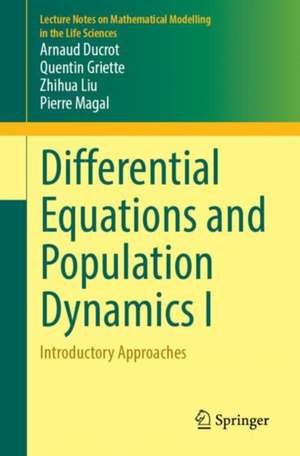Differential Equations and Population Dynamics I: Introductory Approaches: Lecture Notes on Mathematical Modelling in the Life Sciences
Autor Arnaud Ducrot, Quentin Griette, Zhihua Liu, Pierre Magal Cuvânt înainte de Jacques Demongeot, Glenn Webben Limba Engleză Paperback – 21 iun 2022
As an interdisciplinary text, this book aims at bridging the gap between mathematics, biology and medicine by integrating relevant concepts from these subject areas, making it self-sufficient for the reader. It will be a valuable resource to graduate and advance undergraduate students for interdisciplinary research in the area of mathematics and population dynamics.
Din seria Lecture Notes on Mathematical Modelling in the Life Sciences
-
 Preț: 340.61 lei
Preț: 340.61 lei - 15%
 Preț: 496.23 lei
Preț: 496.23 lei - 15%
 Preț: 703.85 lei
Preț: 703.85 lei - 15%
 Preț: 605.02 lei
Preț: 605.02 lei - 15%
 Preț: 422.82 lei
Preț: 422.82 lei - 15%
 Preț: 704.69 lei
Preț: 704.69 lei -
 Preț: 412.58 lei
Preț: 412.58 lei -
 Preț: 543.08 lei
Preț: 543.08 lei - 15%
 Preț: 643.95 lei
Preț: 643.95 lei - 15%
 Preț: 655.77 lei
Preț: 655.77 lei - 15%
 Preț: 474.31 lei
Preț: 474.31 lei - 18%
 Preț: 784.48 lei
Preț: 784.48 lei -
 Preț: 389.70 lei
Preț: 389.70 lei - 15%
 Preț: 586.64 lei
Preț: 586.64 lei - 15%
 Preț: 519.32 lei
Preț: 519.32 lei - 15%
 Preț: 587.85 lei
Preț: 587.85 lei -
 Preț: 456.48 lei
Preț: 456.48 lei -
 Preț: 379.09 lei
Preț: 379.09 lei - 15%
 Preț: 635.84 lei
Preț: 635.84 lei
Preț: 401.42 lei
Nou
Puncte Express: 602
Preț estimativ în valută:
76.84€ • 83.49$ • 64.58£
76.84€ • 83.49$ • 64.58£
Carte tipărită la comandă
Livrare economică 21 aprilie-05 mai
Preluare comenzi: 021 569.72.76
Specificații
ISBN-13: 9783030981358
ISBN-10: 3030981355
Pagini: 458
Ilustrații: XX, 458 p.
Dimensiuni: 155 x 235 x 31 mm
Greutate: 0.73 kg
Ediția:1st ed. 2022
Editura: Springer International Publishing
Colecția Springer
Seria Lecture Notes on Mathematical Modelling in the Life Sciences
Locul publicării:Cham, Switzerland
ISBN-10: 3030981355
Pagini: 458
Ilustrații: XX, 458 p.
Dimensiuni: 155 x 235 x 31 mm
Greutate: 0.73 kg
Ediția:1st ed. 2022
Editura: Springer International Publishing
Colecția Springer
Seria Lecture Notes on Mathematical Modelling in the Life Sciences
Locul publicării:Cham, Switzerland
Cuprins
Part I Linear Differential and Difference Equations: 1 Introduction to Linear Population Dynamics.- 2 Existence and Uniqueness of Solutions.- 3 Stability and Instability of Linear.- 4 Positivity and Perron-Frobenius's Theorem.- Part II Non-Linear Differential and Difference Equations: 5 Nonlinear Differential Equation.- 6 Omega and Alpha Limit.- 7 Global Attractors and Uniformly.- 8 Linearized Stability Principle and Hartman-Grobman's Theorem.- 9 Positivity and Invariant Sub-region.- 10 Monotone semiflows.- 11 Logistic Equations with Diffusion.- 12 The Poincare-Bendixson and Monotone Cyclic Feedback Systems.- 13 Bifurcations.- 14 Center Manifold Theory and Center Unstable Manifold Theory.- 15 Normal Form Theory.- Part III Applications in Population Dynamics: 16 A Holling's Predator-prey Model with Handling and Searching Predators.- 17 Hopf Bifurcation for a Holling's Predator-prey Model with Handling and Searching Predators.- 18 Epidemic Models with COVID-19.
Notă biografică
Arnaud Ducrot is professor of mathematics at the University Le Havre Normandie, France. His research interests include analysis, dynamical systems and mathematical aspects of population dynamics and the natural sciences.
Quentin Griette is an associate professor in mathematics at the University of Bordeaux, France. His areas of expertise include ordinary differential equations, reaction-diffusion systems and the numerical computation of their solutions.
Zhihua Liu is a professor of mathematics at Beijing Normal University, China. Her research interests include differential equations, dynamical systems and applications in epidemics and population dynamics.
Pierre Magal is professor of mathematics at the University of Bordeaux, France. His research interests include differential equations, dynamical systems, numerical simulations and mathematical biology.
Quentin Griette is an associate professor in mathematics at the University of Bordeaux, France. His areas of expertise include ordinary differential equations, reaction-diffusion systems and the numerical computation of their solutions.
Zhihua Liu is a professor of mathematics at Beijing Normal University, China. Her research interests include differential equations, dynamical systems and applications in epidemics and population dynamics.
Pierre Magal is professor of mathematics at the University of Bordeaux, France. His research interests include differential equations, dynamical systems, numerical simulations and mathematical biology.
Textul de pe ultima copertă
This book provides an introduction to the theory of ordinary differential equations and its applications to population dynamics.
Part I focuses on linear systems. Beginning with some modeling background, it considers existence, uniqueness, stability of solution, positivity, and the Perron–Frobenius theorem and its consequences.
Part II is devoted to nonlinear systems, with material on the semiflow property, positivity, the existence of invariant sub-regions, the Linearized Stability Principle, the Hartman–Grobman Theorem, and monotone semiflow.
Part III opens up new perspectives for the understanding of infectious diseases by applying the theoretical results to COVID-19, combining data and epidemic models. Throughout the book the material is illustrated by numerical examples and their MATLAB codes are provided.
Bridging an interdisciplinary gap, the book will be valuable to graduate and advanced undergraduate students studying mathematics and population dynamics.
Part I focuses on linear systems. Beginning with some modeling background, it considers existence, uniqueness, stability of solution, positivity, and the Perron–Frobenius theorem and its consequences.
Part II is devoted to nonlinear systems, with material on the semiflow property, positivity, the existence of invariant sub-regions, the Linearized Stability Principle, the Hartman–Grobman Theorem, and monotone semiflow.
Part III opens up new perspectives for the understanding of infectious diseases by applying the theoretical results to COVID-19, combining data and epidemic models. Throughout the book the material is illustrated by numerical examples and their MATLAB codes are provided.
Bridging an interdisciplinary gap, the book will be valuable to graduate and advanced undergraduate students studying mathematics and population dynamics.
Caracteristici
Covers both basic and cutting-edge material, quickly guiding the reader through the subject Includes MATLAB codes of many figures, preparing the reader for numerical simulations Features a significant amount of new material not included in other books
